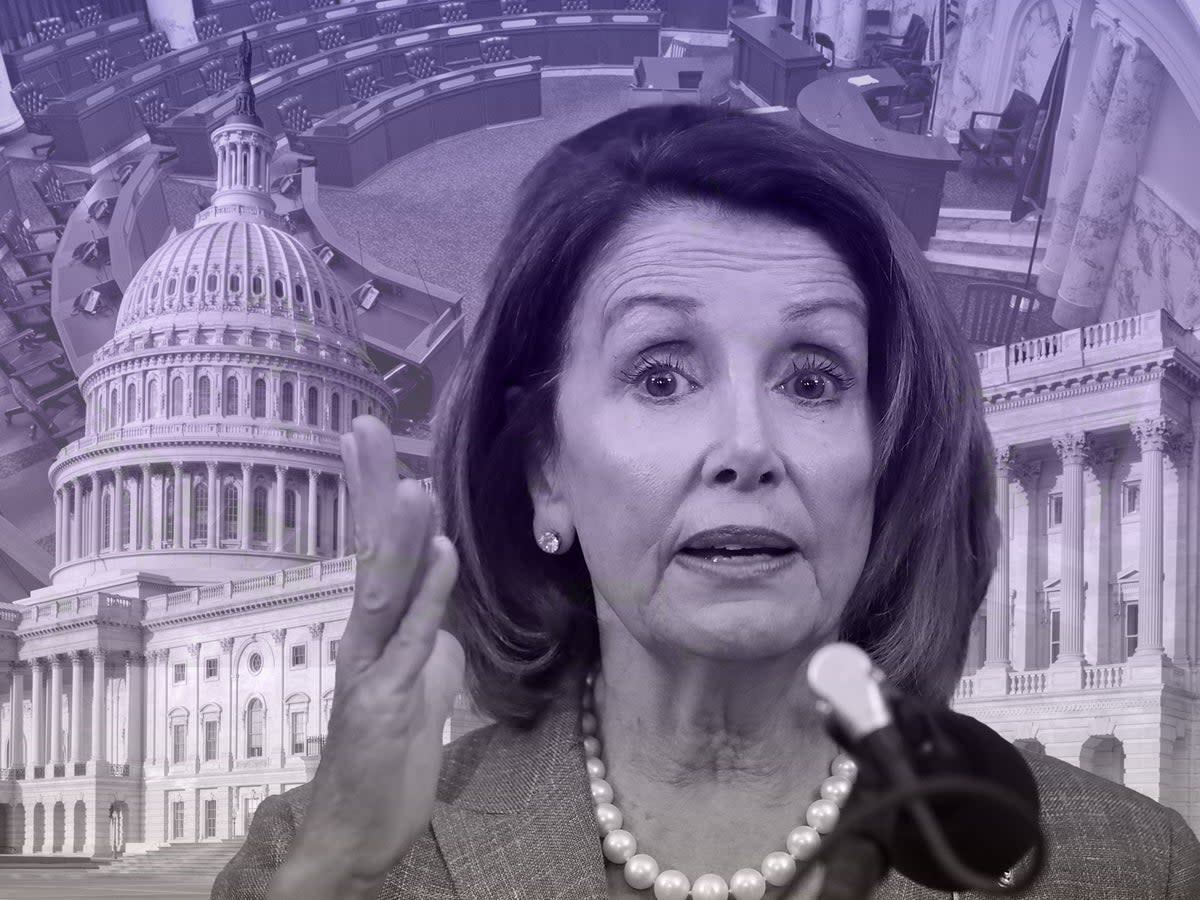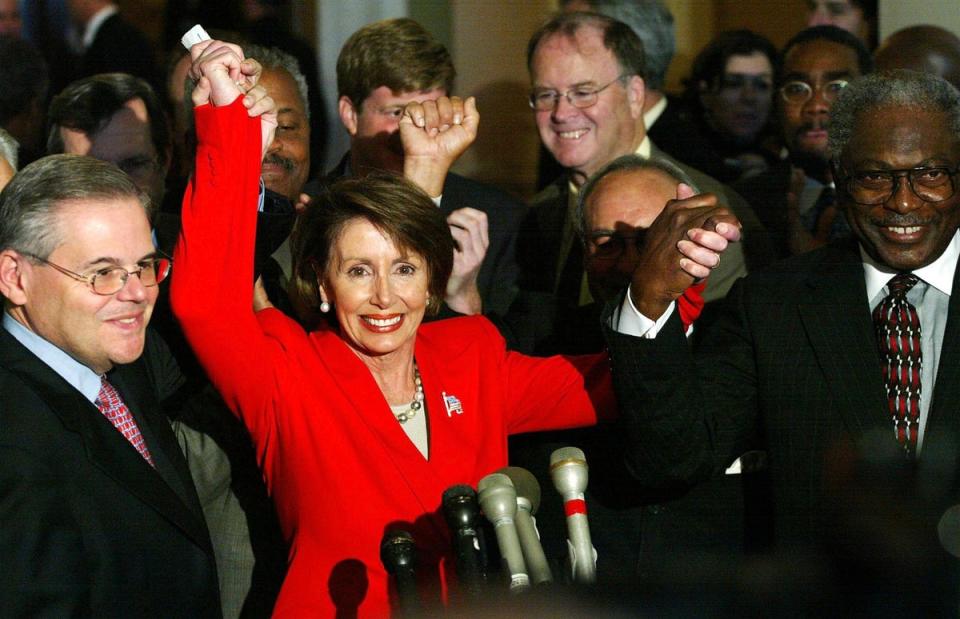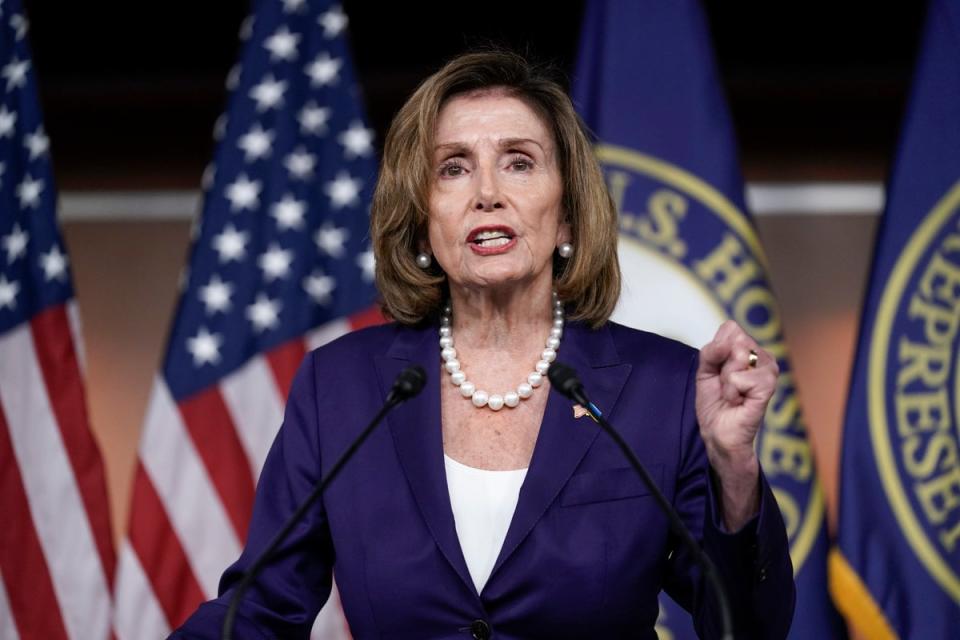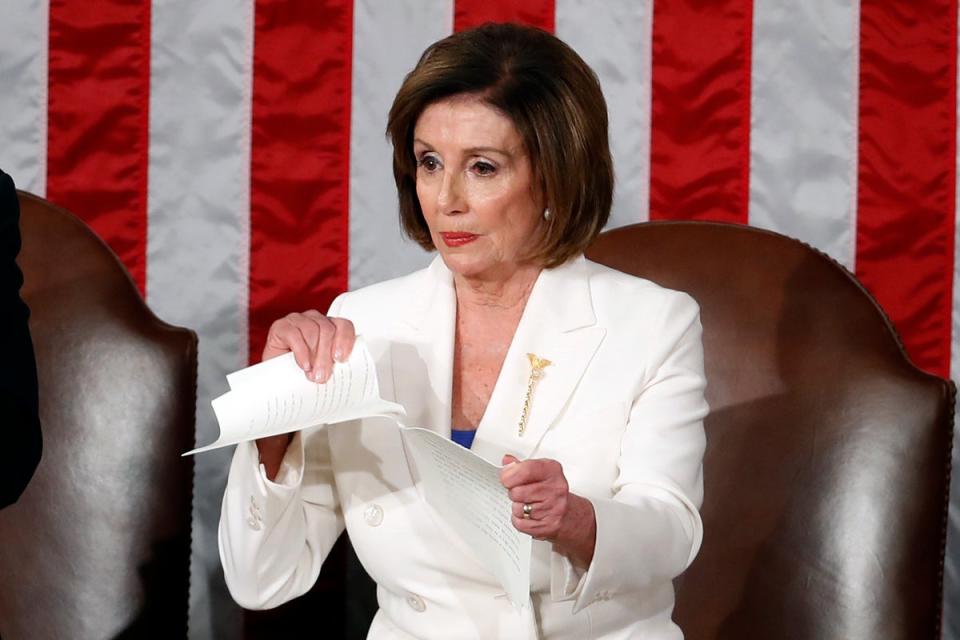Nancy Pelosi: The most powerful woman in American politics. Period.

- Oops!Something went wrong.Please try again later.
- Oops!Something went wrong.Please try again later.
- Oops!Something went wrong.Please try again later.
The day Representative Nancy D'Alesandro Pelosi, became leader of the House Democratic Caucus, the song at the top of Billboard’s “Hot 100” chart was Eminem’s “Lose Yourself”.
The President of the United States was George Walker Bush, the US was executing one invasion in Afghanistan and gearing up to launch a second invasion in Iraq. And the site where the World Trade Centre once stood was still a rubble-filled hole in the ground.
Ms Pelosi, the daughter of a former mayor of Baltimore, Maryland and the sister of another former mayor, had spent most of her adult life in San Francisco with her husband, Paul Pelosi, before being elected to the House in 1987.
On Thursday 17 November, she announced that she would step down from her post as Democratic leader, after Republicans secured a majority in the House of Representatives by a slim majority. Ms Pelosi will continue to serve in Congress.
House Democrats elected her as the caucus whip — the number-two position in leadership — in late 2001. They chose her to lead the caucus after the 2002 midterm elections, when the Republican Party defied historical trends by gaining seats and retaining control of the House despite holding the White House.
She took her place atop House Democrats on 3 January 2003, and the next two decades, Ms Pelosi would maintain an iron grip on her caucus through thick and thin.
Ms Pelosi became the first and thus far the only woman to lead either party in the House or Senate — and would become the first woman to serve as Speaker of the House just three years later after leading Democrats to massive gains in the 2006 midterm elections.

From 2007 to 2011 — and again from 2019, she presided over a string of Democratic victories that advanced long-held priorities for the party and cemented her status as the most powerful woman ever to serve in American politics to date.
Health Care
When Ms Pelosi presided over the House’s final floor vote on the 2010 Patient Protection and Affordable Care Act, she held in her hand a carved walnut gavel lent to her by Michigan Representative John Dingell.

Dingell, who died in 2019, had served in the House since 1955 and had been the member to preside over the chamber when the House passed legislation creating Medicare in 1965.
President Barack Obama’s signature on that legislation put an end to more than a half-century of Democratic attempts to extend health care coverage to all Americans, dating back to President Franklin Roosevelt’s New Deal programme.
During the more than a year of debates over the legislation in the House and Senate, Ms Pelosi’s insistence that the bill had to be passed before it would be known what would be in it was seized on by Republicans as evidence that the Democratic Caucus had lost control and were completely out of touch with the needs of everyday Americans.
Republicans would ultimately ride the outrage over the law, which remains on the books today and is now overwhelmingly popular, to the majority after the 2010 midterm elections. But despite calls for her to step down, Ms Pelosi remained leader of the House Democrats.
Democrats take back the majority and Pelosi takes on Donald Trump
Ms Pelosi’s time as the minority leader — her second stint in that position — came at a time when Republicans were increasingly ascendant despite the continued presence of Mr Obama in the White House.
But when Donald Trump was sworn in as the 45th President of the United States, her return as House Minority Leader in the 115th Congress put her on a path to becoming the first person to lose and regain the Speaker’s gavel since legendary texan Sam Rayburn .

Voters had given Republicans uncontested control of Washington when they put Mr Trump in the White House, but by the time Americans went to the polls on 6 November 2018, the mood in the country had changed significantly.
The US electorate rewarded Ms Pelosi’s caucus with a 41-seat gain, giving them control of the House and making her the most prominent — and most powerful — Democratic politician in the US.
A month later, Ms Pelosi provided a preview of things to come during a now-infamous meeting with Mr Trump and her Senate counterpart, Chuck Schumer, in the Oval Office.
In the weeks following the 2018 election, some Democrats had suggested that Ms Pelosi’s time as leader should come to a close. In particular, some centrist Democrats believed that replacing her would make the party more popular because her decade-plus in leadership had made her a hate object for Republicans, who frequently caricatured her as an out-of-touch, wealthy liberal from ultra-progressive San Francisco who was at odds with the values of so-called “real America”.
Mr Trump alluded to the rumblings among some Democrats when Ms Pelosi and Mr Schumer visited to discuss how to pass a much-needed bill to keep the US government open through the end of 2018.
The then-president was insisting on including funding for his proposed wall along the US-Mexico border in the omnibus funding bill, but the outgoing GOP-controlled Congress couldn’t come to an agreement with the president, who threatened to veto any bill that didn’t fund the wall.
He suggested that Ms Pelosi wasn’t able to negotiate with him because she may not have the votes to become Speaker once more.
“Nancy’s in a situation where it’s not easy for her to talk right now, and I understand, and I fully understand that. We’re going to have a good discussion, and we’re going to see what happens. But we have to have border security,” he said.
Ms Pelosi interjected: “Mr President, please don’t characterize the strength (ph) that I bring to this meeting as the leader of the House Democrats, who just won a big victory”.
After further goading from Mr Schumer, Mr Trump said he would be “proud to shut down the government for border security”.
“I will take the mantle. I will be the to shut it down. I'm not going to blame you for it. The last time you shut it down it didn't work. I will take the mantle of shutting down, and I'm going to shut it down for border security,” he said.
Eleven days later, the government shut down. It would remain closed for more than a month while Mr Trump tried to bully both the outgoing 115th Congress and incoming 116th Congress into funding his border wall.
For Americans who hadn’t paid much attention to Ms Pelosi during her time as minority leader, video footage and wire photographs of her walking out of the White House in a bright peach coat and confidently donning her sunglasses before speaking to reporters became an iconic, instantly-memeable image showing her as the new leader of Democratic resistance to Mr Trump’s policies.

They were about to see a lot more of her over the next two years.
Two years, two impeachments
From the day Democrats took control of the House in 2019, impeachment was a topic of frequent discussion among many House backbenchers.
Representatives who were largely unknown outside their home communities became cable news sensations when they filed articles of impeachment against Donald Trump, even though such measures had little to no chance of passing the House without support from Ms Pelosi and her leadership team.
But even as her committee chairs launched countless probes into Mr Trump’s administration, his private businesses, and the possible nexus between them, Ms Pelosi held off on giving permission for Democrats to follow through on what then-newly-elected Representative Rashida Tlaib vowed rather crudely to do: “Impeach the motherf**ker”.
That all changed on 24 September of that year, when Ms Pelosi strode to a lectern outside her office and announced that the House would pursue an inquiry into whether Mr Trump would be impeached for seeking help from a foreign leader to damage a potential 2020 election opponent.
“The actions of the Trump presidency have revealed the dishonorable fact of the president’s betrayal of his oath of office, betrayal of our national security and betrayal of the integrity of our elections,”she said, standing before a backdrop of American flags. “Therefore, today, I am announcing the House of Representatives is moving forward with an official impeachment inquiry”.
After a month of depositions and investigations by the House Intelligence, Oversight, and Foreign Affairs committees, the House voted to authorise a series of hearings before the Intelligence Committee (led by a close ally of Ms Pelosi, Representative Adam Schiff).
Mr Schiff’s panel ran a monthlong set of investigative hearings during which a set of blockbuster witnesses testified that Mr Trump had indeed tried to hold up hundreds of millions of dollars worth of defence aid to Ukraine as a way of forcing Ukrainian President Volodymyr Zelensky to announce investigations into Joe Biden and his son, Hunter Biden.
The Intelligence Committee adopted a report finding that Mr Trump “personally and acting through agents within and outside of the U.S. government, solicited the interference of a foreign government, Ukraine, to benefit his reelection”. On 10 December, the House Judiciary Committee announced that it would consider two articles of impeachment against the president, charging him with abuse of power and obstruction of Congress. The House approved both on 18 December, making Mr Trump just the third US president to face trial in the Senate.
Mr Trump’s Senate trial started in mid-January 2020, and wrapped up with his acquittal by all GOP senators save for Utah’s Mitt Romney.
Just under a year later, rioters stormed the Capitol in hopes of preventing Congress from certifying Mr Trump’s loss to Mr Biden, with some screaming Ms Pelosi’s name as they searched for her while ransacking her private office.
On 13 January — nearly a year to the day that Ms Pelosi had signed off on Mr Trump’s first impeachment — the House voted to impeach him a second time for inciting the riot.
This time, seven Republican senators joined with the upper chamber’s Democrats and independents in judging Mr Trump guilty, but even that wasn’t enough to meet the two-thirds threshold to convict him.
Bipartisan triumphs
Despite Mr Biden’s defeat of Mr Trump, Democrats only held a five-seat majority when the 117th Congress convened on 3 January 2021.
Ms Pelosi, who did not face a serious challenge to her leadership this time, won the speakership once more and immediately mobilised her caucus to implement Mr Biden’s legislative agenda.
Despite frequent claims that the House Democrats were in “disarray” due to disagreements between progressives and more moderate members, the Speaker was able to keep her caucus together often enough to pass the largest infrastructure bill since the authorisation of the Eisenhower-era Interstate Highway System, as well as landmark gun safety legislation, Covid relief, and, if the Senate acts to approve it, a bipartisan bill to codify same-sex marriage rights.
For Ms Pelosi, who was elected to represent San Francisco at the height of the HIV/Aids crisis, seeing same sex marriage rights written into the US code would be a fitting send-off, and a reminder that she has moved more major legislation through her chamber with a smaller majority than any Speaker in US history.

